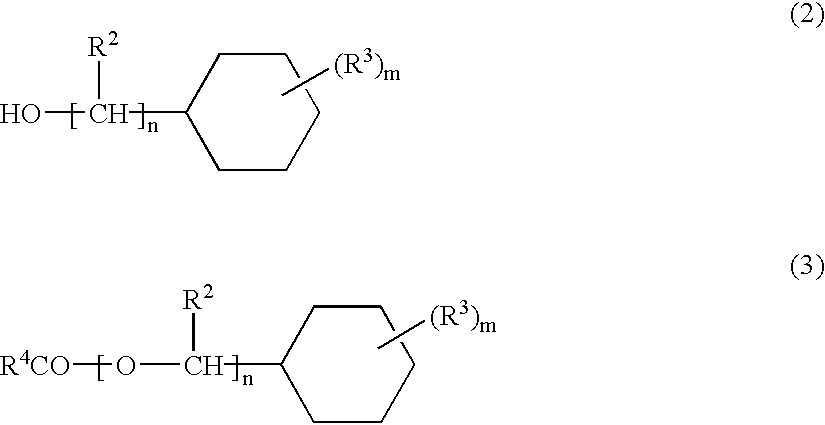(Meth)acrylate ester-based resin composition
- Summary
- Abstract
- Description
- Claims
- Application Information
AI Technical Summary
Benefits of technology
Problems solved by technology
Method used
Image
Examples
examples 2 to 6
[0197] and
Comparative Examples 1, 2
[0198] Polymers of Examples 2 to 6 and Comparative Examples 1, 2 were obtained in the same way as of Example 1 except that the polymerizable monomer components, the amount of the polymerization initiator, and the reaction temperature, as used in Example 1, were changed to those which are shown in Table 1. Their nonvolatile contents, viscosities, and number-average molecular weights are shown in Table 1. Furthermore, the same procedure of the prescription for paint preparation as of Example 1 was repeated to obtain two-liquid type urethane resin compositions.
example 7
[0213] Titanium oxide (Tipaque CR-95, produced by Ishihara Sangyo Kaisha, Ltd.) was added to the acrylic polyol resin liquid, as obtained in Example 1, so that the pigment concentration in the nonvolatile content would be 40 weight %, and the titanium oxide was well dispersed into the acrylic polyol with a sand mill, thus obtaining a dispersion. A melamine resin Cymel 303 (nonvolatile content=100 weight %, produced by MITSUI CYTEC LTD.) was weighed out in an amount of 25 parts per 75 parts of the nonvolatile content of the aforementioned acrylic polyol and then mixed with the above dispersion, and then the resultant mixture was diluted to a spray-coatable viscosity with a thinner of xylene:butyl acetate=1:1, thus obtaining an acrylic melamine resin paint composition.
[0214] (Acrylic polyol / poly(blocked isocyanate) compound):
example 8
[0215] Titanium oxide (Tipaque CR-95, produced by Ishihara Sangyo Kaisha, Ltd.) was added to the aforementioned acrylic polyol (as obtained in Example 1) so that the pigment concentration in the nonvolatile content would be 40 weight %, and the titanium oxide was well dispersed into the acrylic polyol with a sand mill, thus obtaining a dispersion (hereinafter referred to as liquid I). A multifunctional blocked isocyanate (Sumidur BL-3175, produced by Sumitomo-Bayer Urethane Co., Ltd.) was weighed out as liquid II in such an amount that the equivalent ratio of the isocyanate group to the hydroxyl group of the aforementioned acrylic polyol in the above dispersion (liquid I) would be 1:1. These liquids I and II were mixed together and then diluted to a spray-coatable viscosity with a thinner of xylene: butyl acetate=1:1, thus obtaining a two-liquid type urethane resin paint composition.
[0216] The paint compositions as obtained in Examples 7 and 8 were spray-coated onto zinc-phosphated ...
PUM
| Property | Measurement | Unit |
|---|---|---|
| Percent by mass | aaaaa | aaaaa |
| Percent by mass | aaaaa | aaaaa |
| Temperature | aaaaa | aaaaa |
Abstract
Description
Claims
Application Information
 Login to View More
Login to View More - Generate Ideas
- Intellectual Property
- Life Sciences
- Materials
- Tech Scout
- Unparalleled Data Quality
- Higher Quality Content
- 60% Fewer Hallucinations
Browse by: Latest US Patents, China's latest patents, Technical Efficacy Thesaurus, Application Domain, Technology Topic, Popular Technical Reports.
© 2025 PatSnap. All rights reserved.Legal|Privacy policy|Modern Slavery Act Transparency Statement|Sitemap|About US| Contact US: help@patsnap.com



